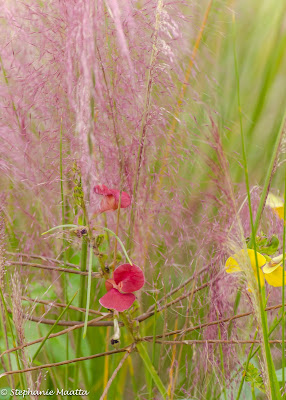 |
| Sunflower Bright, copyright 2015, Stephanie Maatta Smith |
Recently I had the pleasure of participating in a local
artists’ challenge. While the subject of the challenge was “sun flower” and our
artistic interpretations of this subject, the discussion began with Fibonacci Sequence, or the
Golden Ratio. This is, of course, a foundational concept of artistic
composition, and one that occurs naturally in nature.
Without going into a long explanation the Fibonacci sequence
is a mathematical sequence that forms a spiral as the numbers become larger and
are combined into squares. (Here’s a link to a quick and easy explanation of
the math.) The start of the sequence is 0, 1, 1, 2, 3, 5, 8, 13; the sequence
develops by adding succeeding numbers together (0+1 = 1; 1+1 = 2; 2+1 = 3 and
so on). What’s even more intriguing is the aspect of ratio in the sequence,
with each pair of successive numbers having the same approximate ratio of
1:1.61.
 |
| Ponce Lighthouse Stairs, copyright 2012, Stephanie Maatta Smith |
The Golden Ratio is sometimes considered a "souped up version" of the Rule of
Thirds. Ah, yes, we all nodded our heads sagely; we’ve heard of the Rule of
Thirds. Using the rule of thirds, the artist or photographer creates an image
by imagining a 3 x 3 grid overlaid on the frame and positioning the subject
carefully on one of the intersecting lines; thus, drawing the viewer into the
image and leading him or her to the subject. By employing the Golden Ratio of
1:1.61 and envisioning the resulting spiral in conjunction with the Rule of
Thirds, creative works become harmonious and pleasing to the eye. It’s the foundational principal that makes a
work of art, photography, and architecture feel right and all visual elements
in proportion to each other.
 |
| Daisy Central, copyright 2014, Stephanie Maatta Smith |
The spiral and corresponding mathematical sequence are seen
repeatedly in nature. For example, the seed heads of a sunflower are formed in
outward reaching spirals with the seeds becoming larger as they reach to outer
edge. The same pattern is seen in the carpel and stamen of a daisy. In nature,
this design not only looks pleasing, but also serves a purpose. Seeds, petals,
leaves grow in this pattern to give stability to the plant structure and to
allow all of the leaves and seeds to receive light and water, ensuring growth
and reproduction.
For more on the Fibonacci sequence and Golden
Ratio in photography, check out this Digital Photography School article.
















